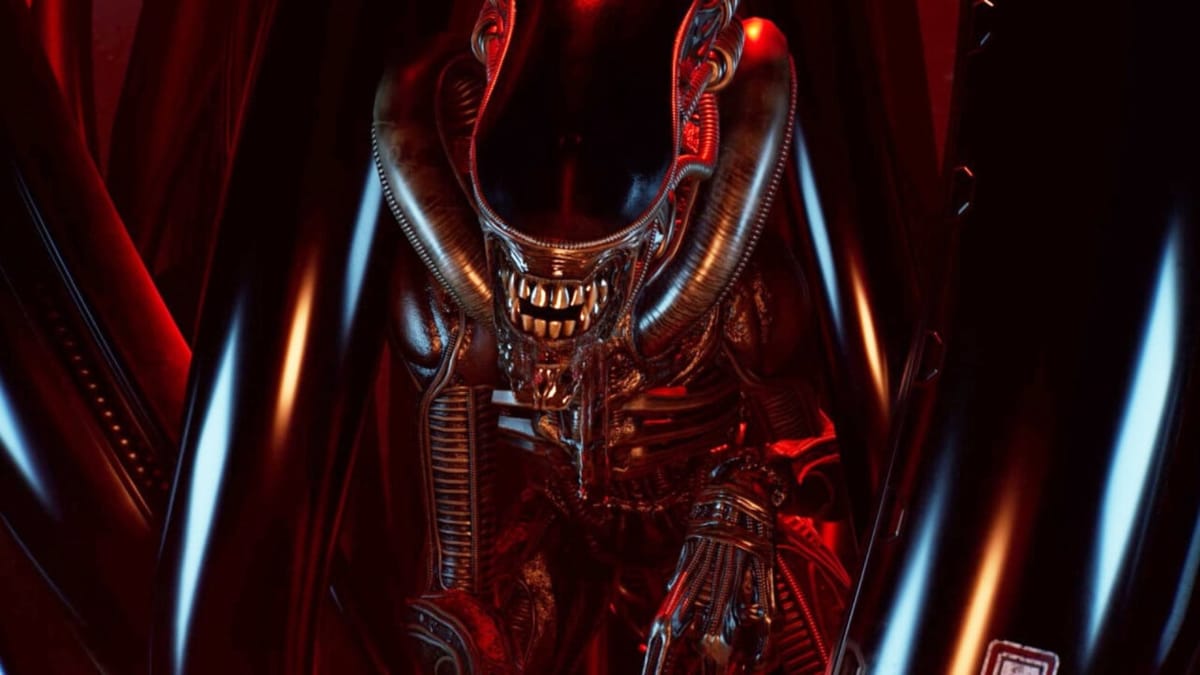
The first Alien movie was revolutionary for its time. Ridley Scott spent 45 minutes building a palpable tension for the audience, keeping them in the dark about the true nature of the Xenomorph threat. James Cameron’s sequel is a masterclass in reinvention, giving us one of the best action movies ever made. The aliens were omnipresent, terrifying, and destroyed an entire squad of veteran soldiers with ease. What both did right, and nearly every subsequent film did wrong, was make fear the star. That is PRECISELY what Developer Tindalos Interactive has done with Aliens: Dark Descent, and I’m here to tell you that it’s absolutely brilliant.
I’m a bit of a shill for Swiss artist H.R. Giger and his macabre and horrifying body of work. I have a replica of the 1970s “Big Chap” Xeno (my unboxing) sitting behind me as I write this, as well as at least a dozen of the creatures in various forms on or around my desk. My escape key keycap is a 3D printed Xeno head. I even have a huge stuffed facehugger. To say that I’m a fan is an understatement. While that sounds like I’d give anything with the titular creature in it a pass, it couldn’t be further from the truth. Time and again I’ve been disappointed, making me a fairly harsh critic. When I saw the trailer for Aliens: Dark Descent I went in with open eyes, knowing that this could easily be another game filled with all the promise and components, but once again failing in its execution. I’m happy to report that we finally have a great Aliens tactical game, after over 20 years of waiting. Let’s dig into what makes Dark Descent into something special.

The game starts off with just another routine day on an orbital station above the planet Lethe. People move about their day, and Administrator Maeko Hayes starts her shift with a quick check on yet another mundane cargo move. Boredom turns into abject terror as she discovers things aren’t quite as they seem, punctuated by a breached container and a bloodbath spraying in all directions. Not the type to wait around to find out, Maeko immediately works to lock down the station, calling in the Marines for help. Naturally, things go horrifyingly wrong, forcing her to enact a scorched Earth protocol to purge the station. Through her escape with the summoned Marine squad (lead by USCM Sergeant Jonas Harper who has an uncanny knack for somehow seeing what’s around the corner), they all end up marooned on the planet surface below. Stranded, under constant threat, and with almost no resources, their terror has only just begun…
At its core, Aliens: Dark Descent is a blend of XCOM-like punishing gunplay mixed with realtime constant motion and painted with a layer of survival horror. Maeko and Jonas act as the civilian and military counterparts that will help guide the missions your Marine squads will tackle. Under these two you’ll deploy dozens of Marines that you’ll need to train, upgrade, and somehow help survive time and again. Beyond these Marines and their leadership you’ll also encounter researchers, doctors, administrators, mechanics, and more who will hopefully come together to help you get off this forsaken wreck of a moon. The missions you’ll tackle, however, are anything but straightforward.
During your escape from the orbital station, the Marine ship USS Otago is downed. Those that survived the crash immediately spring to life, turning the wreckage into a forward operating base. Thankfully the planet isn’t uninhabited – there are several horrifyingly-named colonies. Your first mission, the “Dead Hills Colony” has stopped responding to comms, so it’s time to head out for a bit of recon and rescue.
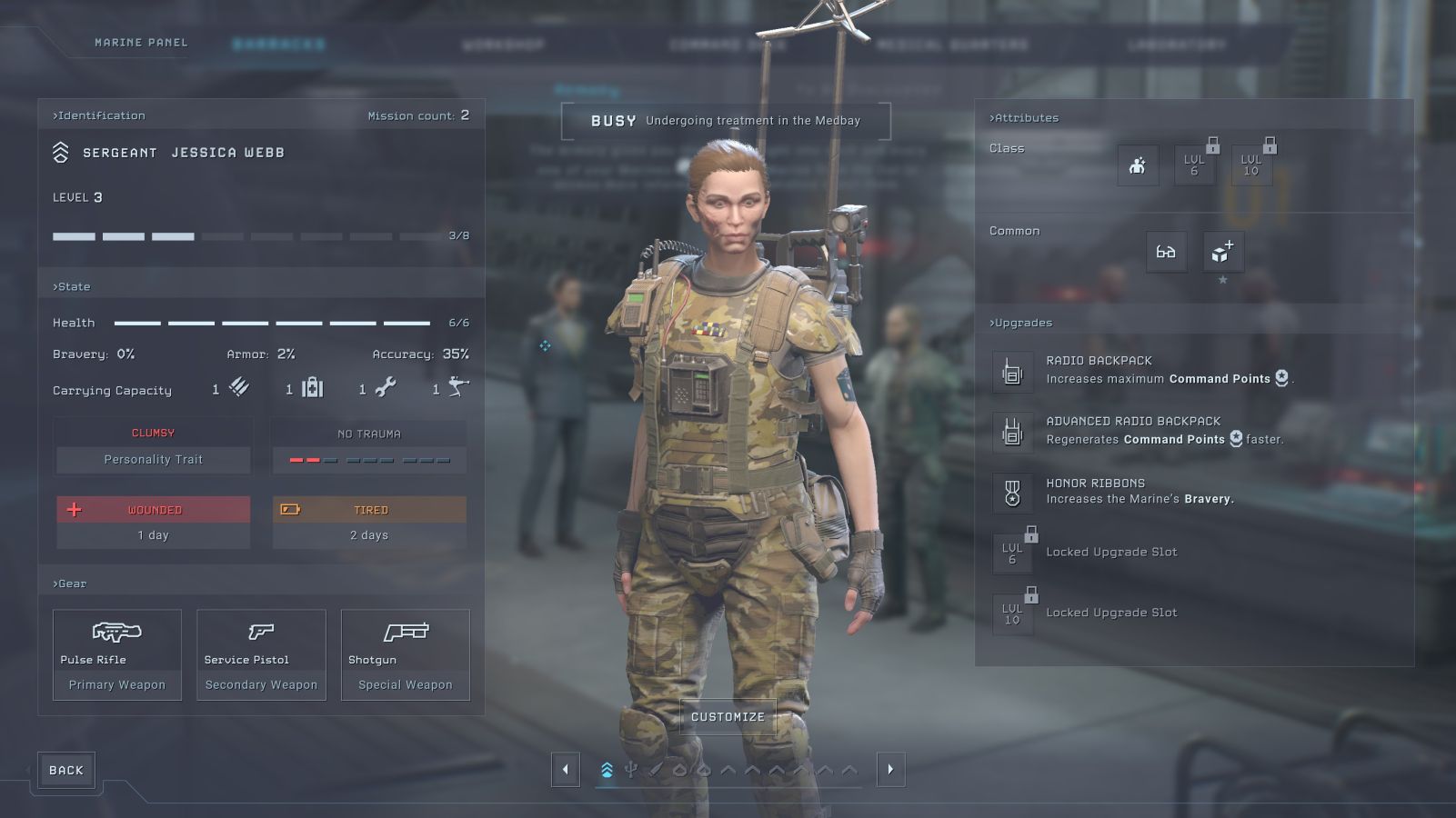
Every mission, including the very first one, is lengthy. You’ll set out with just four Marines, all of which are rookies. As rookies, they all come with positive traits that can help with stats and skills, but also some negative ones. These can have a direct impact on their hit stats, luck finding materials, how fast they can pack gear, or worse. We’ll get back to some specific examples when we talk about psychology, as it turns out this can have a far worse effect on your mission as they go on.
When you arrive at Dead Hills, you’ll see that you have just a single primary objective, but there’s a solid list of data pads to recover and materials to pick up. Your crew moves as a team, as they should, slowly inching through the darkened corridors and hallways. Your team has chest-mounted flashlights, but those won’t illuminate much. Instead, you’ll hold down the left mouse button for a directed flashlight beam. This will let you see to the end of hallways, as well as highlight any interactive elements in the environment. It also showcases the absolutely phenomenal lighting engine present in Dark Descent. The light bends and twists around ordinary objects, making something as simple as a desk chair’s shadow look sinister at the right angle.
As you move through the colony you’ll find…well, precisely what you expect. More breached shipping containers, more blood, more threats. At some point, you’ll come fact to face with the titular xenomorphs. Battered and bloodied, at some point it’s going to be too much, and that’s where the risk/reward aspects of the game come in.
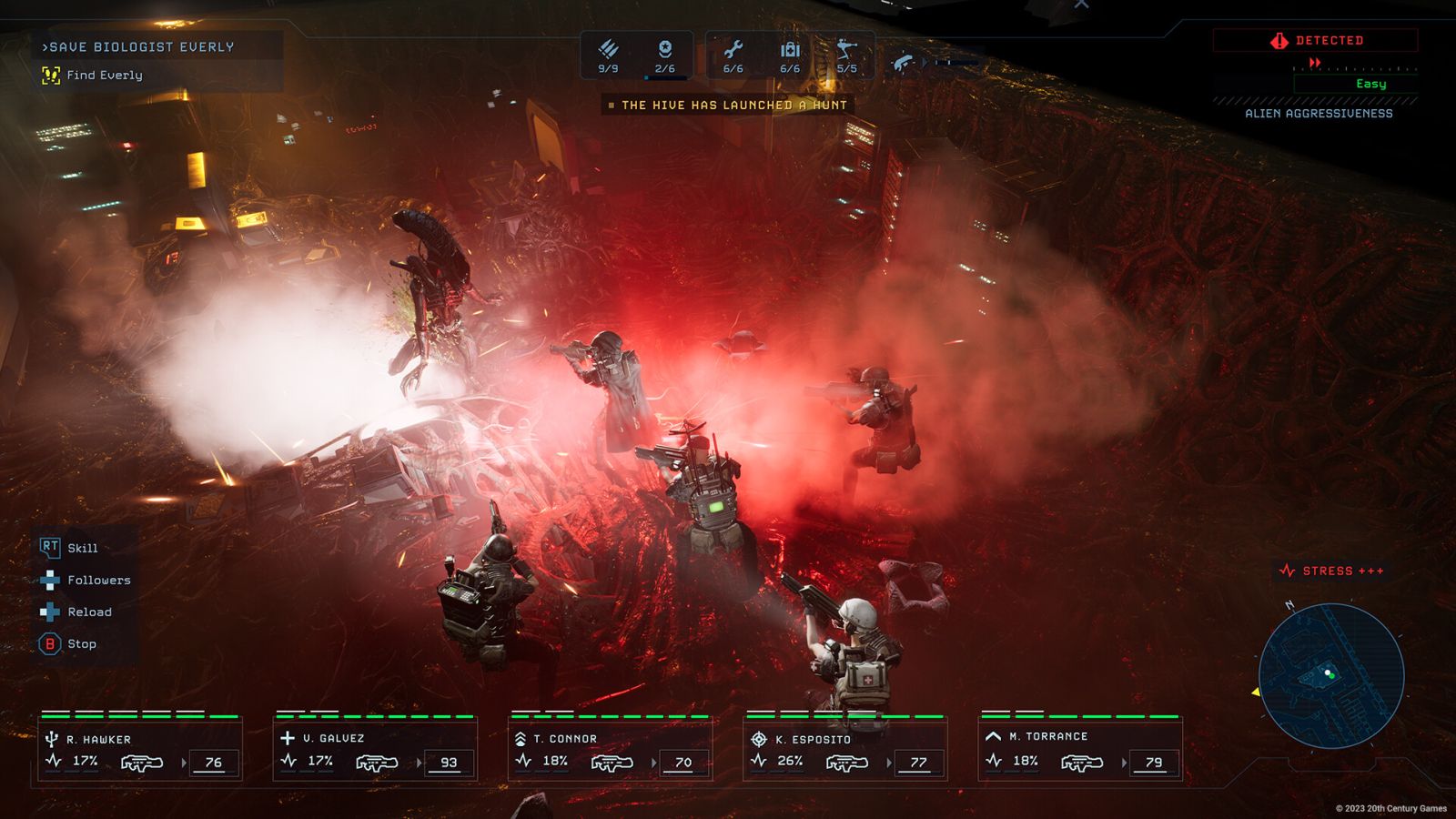
Nearly every mission can be tackled in parts. Heading back to the Armored Recon Carrier (ARC) you can high tail it out of there to fight another day with whatever you’ve managed to recover from the mission. Your Marines will reap the rewards of their experience, going up levels, picking class specializations, and getting the opportunity to use their recovered materials for research and to buy new weapons. Before you get the bright idea to put them back on the boat for another fight, let’s talk about mental fatigue.
After a bit of repairs on the Otago you’ll eventually unlock the Psychiatric Care Unit. Marines under stress can develop quirks over time, and left unchecked, they can become problematic. One might become paranoid, taking a constant but small bit of mental damage when they are in a squad of more than 3. My Sergeant that regularly deploys with the Incinerator, callsign “Torchy”, suddenly developed Pyrophobia. This means any time she uses her special weapon, or oil is set on fire, she takes 15 stress damage. Somebody needs a new callsign, or at least a few days in Psychiatric care. Ignore your soldier’s mental state at your own peril – you don’t need them breaking in the field when you need them most.
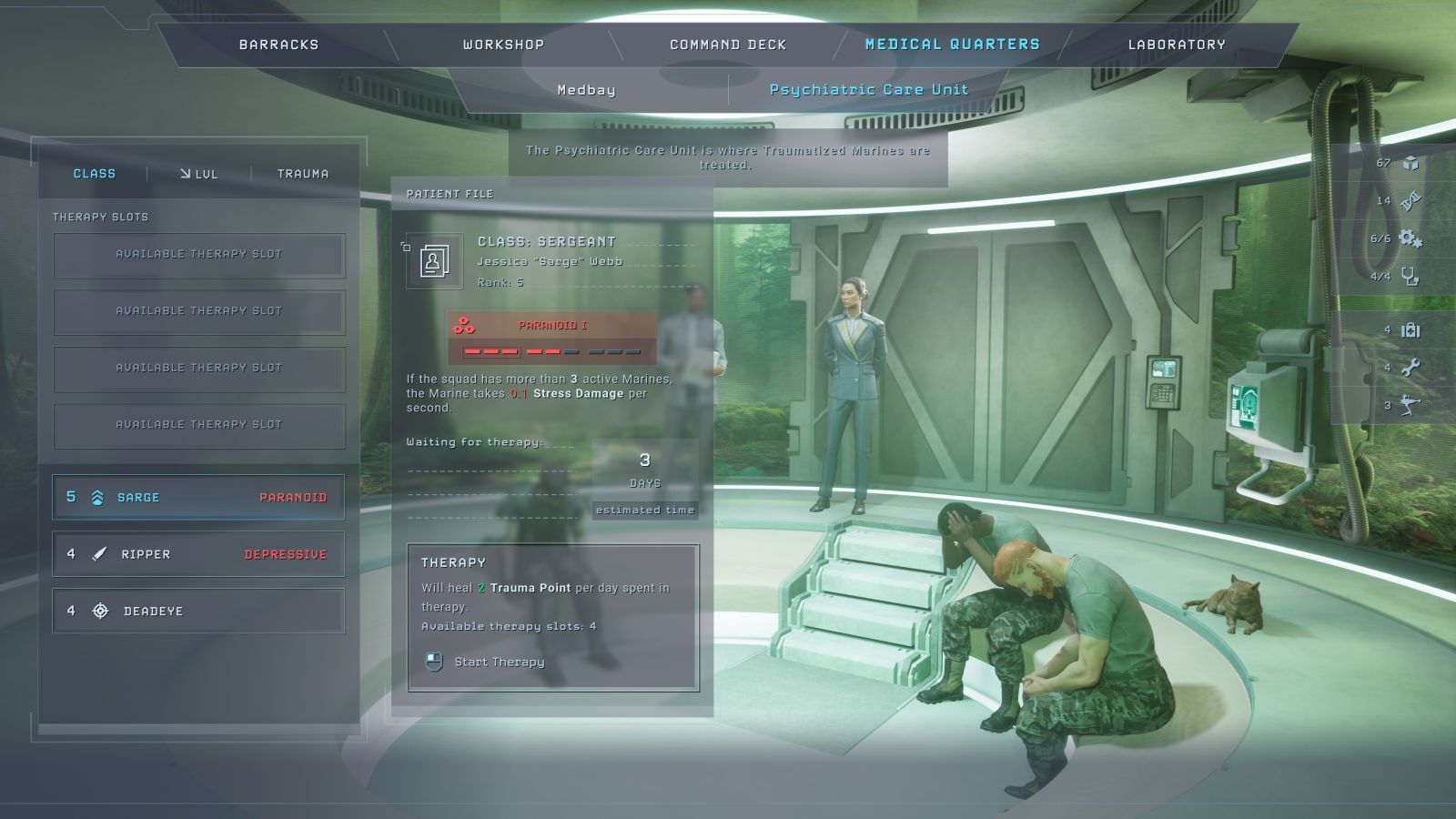
Naturally you are probably going to become attached to some Marines as well. I don’t recommend it as they are relatively soft and squishy compared to their enemies, but it happens. What about the rest of your squad while they are off saving the world? Well, once you’ve unlocked the Training Room…they train. They’ll earn partial XP while other Marines are out in the field, or you can send them to more intensive training for double XP, though this pulls them off the board to be deployed for missions and healing, and they’ll come out of it exhausted. Still, that might be worth it for when your favorite sniper ends up traumatized by seeing entirely too much. In the Otago’s medbay, you can also assign medics to shorten recovery times or even attach prosthetics to your Marines when things go particularly poorly. You’ll spend a lot of time here, so when you find a doctor you can rescue in the field, don’t miss out.
Not ending up as Xenomorph lunch meat is all about effective command of the battlespace. Your marines move as a unit and typically work remarkably well together. Each Marine has a motion tracker (which translates onto your mini-map on the bottom right of the screen), a primary, secondary, and special weapon. And you’ll need weapons aplenty to fend off what lies in the dark. Thankfully your Engineering team is able to scare up armaments to help even the score a bit. The iconic M41 Pulse Rifle, the M4A3 Service Pistol, the always-magnificent Smart Rifle, the Shotgun (good for close encounters), and the M240 Incinerator are your staples, but hardly the whole roster of guns you’ll bring to the field. In fact, there are a total of 14 to unlock by your Engineers in the Workshop, but I don’t want to ruin the surprise of uncovering them all. You can also collect Xenosamples from the dead creatures which will provide the resources necessary to research special weapons such as stun and shock grenades and other toys, though revealing these might be a bit of a spoiler, so we’ll skip it.

The Barracks are where you’ll find your Marines, naturally. It’s also where you can spend “Exceptional Material” (seriously, what is this stuff?) to buy upgrades for your soldiers. You’ll find things like expanded ammo bags, expanded pouches for tools and medical supplies, and the ability to hack faster. Bigger upgrades await you at levels 1, 2, 3, 6, and 10, with class specialization bringing you even more upgrades. These can be radio backpacks or drones that can act on your behalf, but each Marine can only carry so much, so you’ll need to balance out your gear and upgrades. There are over two dozen upgrades to discover and research, including wider clips (aka high-capacity mags), ammo bags to carry additional mags into the field, iron will, immunity to fear, and more. And you’ll need every bit of it, too – there are ten variants of the Xenomorphs to contend with, with the drone variants being the least of your problems.
The Command Deck is where you’ll launch missions, pushing the story forward. In the beginning your missions are fairly linear, but over time you’ll have other opportunities to make decisions about where to go next. Some of these missions require your direct attention, deploying and controlling your squad directly, whereas others might simply deploy them and hopefully they come back intact. These start off easy and risk-free, but after a short while you’ll start running into tougher calls, or worse, a few lose-lose situations.
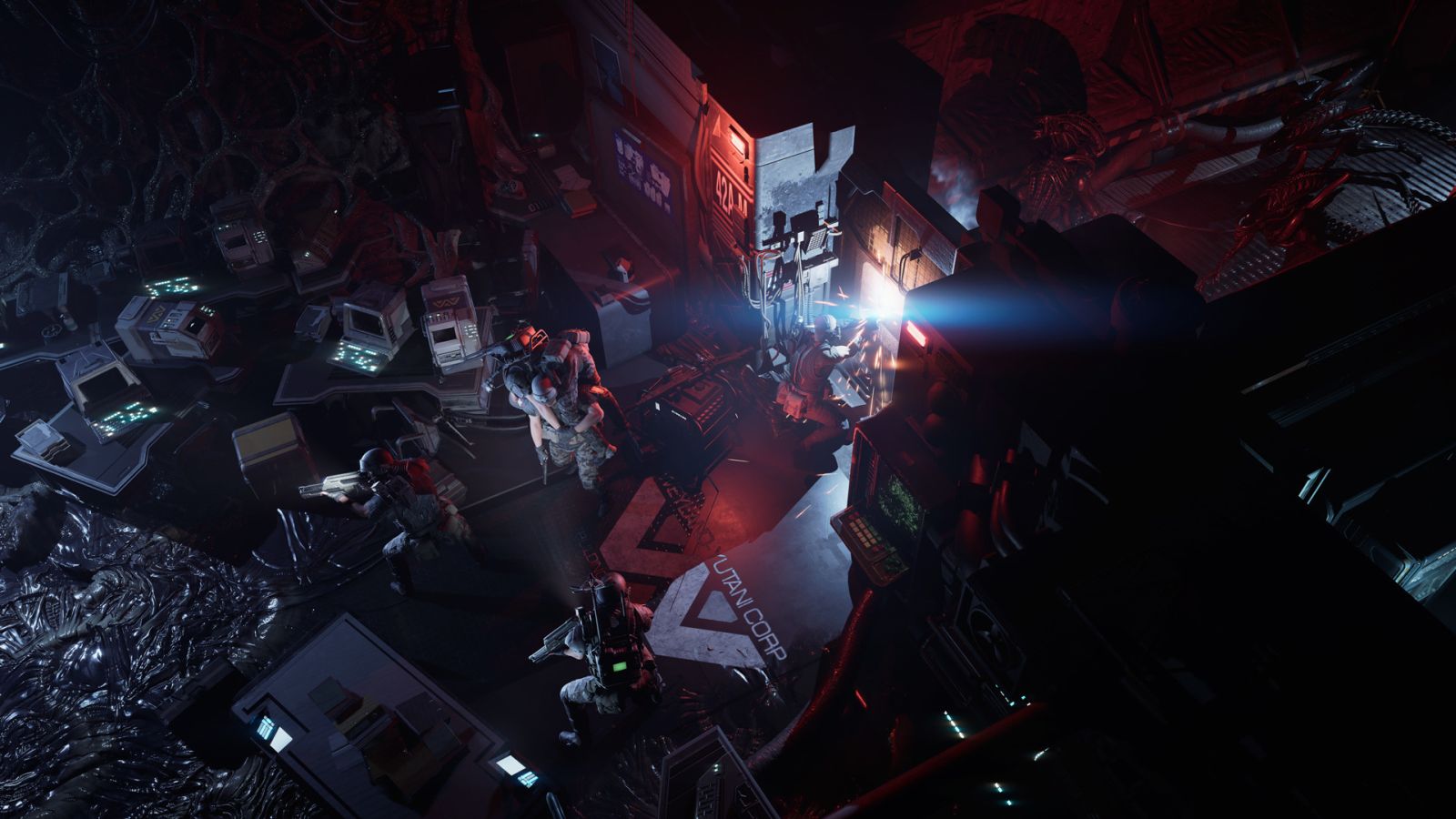
Eventually, despite training, weapons, preparation, or all the screaming your lungs can muster, things will go sideways. Marines can get downed and incapacitated. If the wounds aren’t too bad, a simple medkit can put them back in the fight. Take a particularly nasty blow, however, and you may lose a limb. If it’s really not your day, the Xenos may just grab you and drag you off to…well, you probably don’t want to know what happens at the end of that sentence. A fast acting team can stop that alien and rescue you, though it likely means one of them will have to haul their sorry butt back to an exfil zone or APC. Similarly you’ll find survivors that you can bring back to the Otago to help build out your Forward Operating Base, so you’ll need to escort them around, or walk them back to the APC. More risk/reward as those civilians most certainly can and will be killed on a long enough timeline.
To help balance health, stress, and mental fatigue, eventually you’ll need to hunker down and rest. If you picked up a welding kit, or had the sense to bring some, you can weld the doors on almost any enclosed space and barricade yourself in it for some much-needed downtime. If you pick a big space you might need four of them to weld all the doors, so it might make sense to find something closer to a broom closet. That said, your foes can and will bash down the door to get to you if they realize where you are, which could make that small space either a chokepoint to gun everything that steps into the space into mincemeat, or it could end up being a convenient place for the janitor to clean later as all of your corpses are contained in a tiny space. No matter how you choose, these engineering kits are also used to hack doors, unlock data on table maps, and more, so you might keep an eye on that count lest you find yourself with a crew on the edge of losing their cool and nowhere to hide.
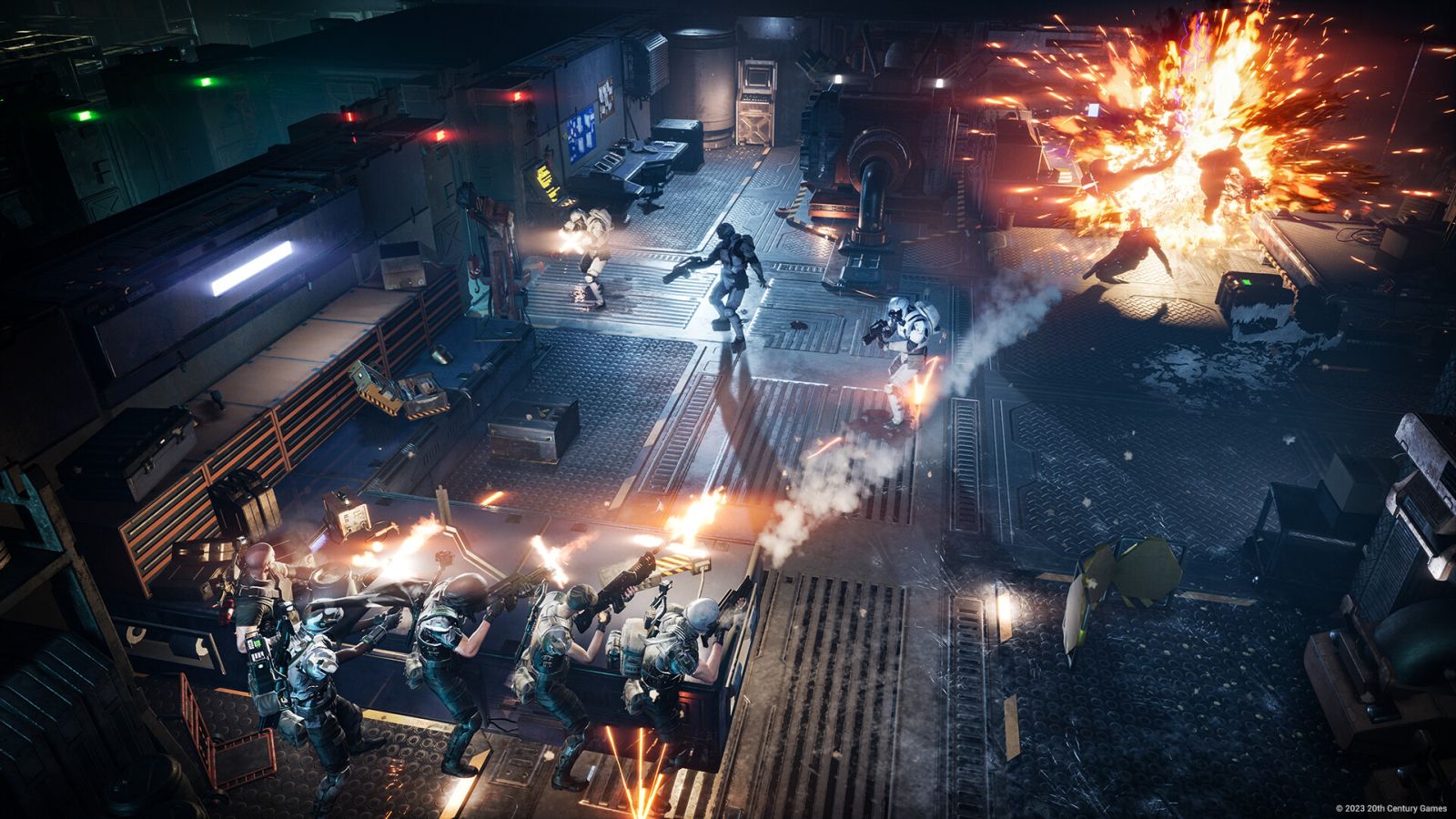
If you’ve not gathered, the action can become completely overwhelming in Dark Descent. Activating the various skills your Marines will earn will trigger a slowdown mechanic where you can trigger a shotgun blast, launch a grenade, deploy a smartgun, or flow liquid fiery death down a hallway with the Incinerator. These points recover over time, and faster based on the skills and attributes of your Marines, allowing you to unleash them again. There are ammo counters on your primary weapons (and ammo to recover in the field), but these command skills are unlimited. It’s just one more well-crafted and interconnected system that works well and keeps you starved for resources in the best way possible.
There are four different difficulty levels in Aliens: Dark Descent ranging from Story to Nightmare, with a Custom mode hanging out for full customization. These allow you to tweak enemy hitpoints, enemy detection, aggressiveness gain delay (host fast enemies get pissed off at your actions) and the Death Clock, which is the amount of time until you are spotted. The most significant adjustment is to the Save System as it either is rather permissive or limits you to just two. Since these are rotated quickly, you can’t even roll back very far, so it’s aptly titled “No One Can Hear You Scream”. Since you can’t change this difficulty level once the game begins, you’ll want to take a moment before you make your choice.
Developer Tindalos does need to set out on a few more bug hunts for Dark Descent. I had one mission where one of my Marines got stuck on a shipping container. I didn’t realize this until my troops all gathered up and I realized I was one nugget short of a Happy Meal. I went back and retrieved my stuck trooper, but then realized that none of my crew would follow orders. They couldn’t open boxes, weld doors, or interact with anything, forcing an unnecessary reload. I moved my Marines through a different path through the containers and somehow one of them got stuck again. This one section took me too many attempts just to navigate, forcing me to spend my Engineering resources to save more frequently than I would have otherwise. Thankfully the rest of the bugs I saw were mostly the enemy not paying attention to their friends dying nearby, allowing me to exploit the battlespace, or one Xeno Queen who just decided she’d had enough, standing there and taking shots without complaint until she died. These bugs sound major, but other than the shipping container one, they aren’t a big deal in the grand scheme of things. There are plenty of threats, making a single malfunctioning one (even a Queen) a laughable drop in the overall danger bucket.

One area where frustration did creep in, however, are occasional selection issues, and the cover system with a controller. I ran into one issue where I couldn’t put my wounded Marine into the ARC because the game kept selecting the nearby Sentry gun instead, despite it being about 50 yards away and in an entirely different building. Packing that turret away stopped the selection problem, but I still couldn’t move the cursor down to “Secure Marine” on the ARC. Instead I had to move the empty ARC to another location, which allowed my team to secure their wounded compatriot once they humped their way over there. The other issue came from trying to use the cover system with a controller. With mouse and keyboard it’s very easy to find the spot where your troops will take cover as a small set of dots will appear, and pressing CTRL there will have them seek refuge behind it, ducking down to avoid incoming fire. With the controller I really struggled to make these selections in any sort of timely fashion. Cover isn’t always a necessary part of the overall strategy, but when you need it, you REALLY need it. With that, I’d heartily recommend you stick to a mouse and keyboard for this one.
Though I’m reviewing this on PC, I’m happy to report that Aliens: Dark Descent looks magnificent on the Steam Deck, running 30fps locked on the handheld, and without having to lower any settings to potato level.
Alien games have been a mix of awesome, good, bad, and awful, with an unfortunate tilt towards the latter for the majority of them. Thankfully, Aliens: Dark Descent joins the likes of Alien: Isolation, Aliens vs. Predator 1 and 2, and Aliens: Fireteam Elite that lean heavily into the abject creeping terror, environment, and overall dread that make the first two films absolute classics. It’s rare that a game nails the atmosphere and tension of a setting so perfectly, but Dark Descent is the kind of game that’ll make you paranoid – and I love it.
Aliens: Dark Descent
Excellent
Aliens: Dark Descent is a masterful blend of atmosphere, tension, and terror, coming together with dangerous combat and well-paced progression. The end result is a game that keeps you on your heels while making you feel like you’re “state of the badass art”.
Pros
- This game is TENSE
- Excellent progression that forces tough choices
- Risk/reward mission structure
- 100% faithful sounds, straight from the films
- 25+ hour campaign, minimum
Cons
- Some repeatable pathing bugs can impact in-game resources
- A few AI hiccups where they ignore threats
- Thankfully infrequent selection oddities
- Cover can be clunky with a controller
